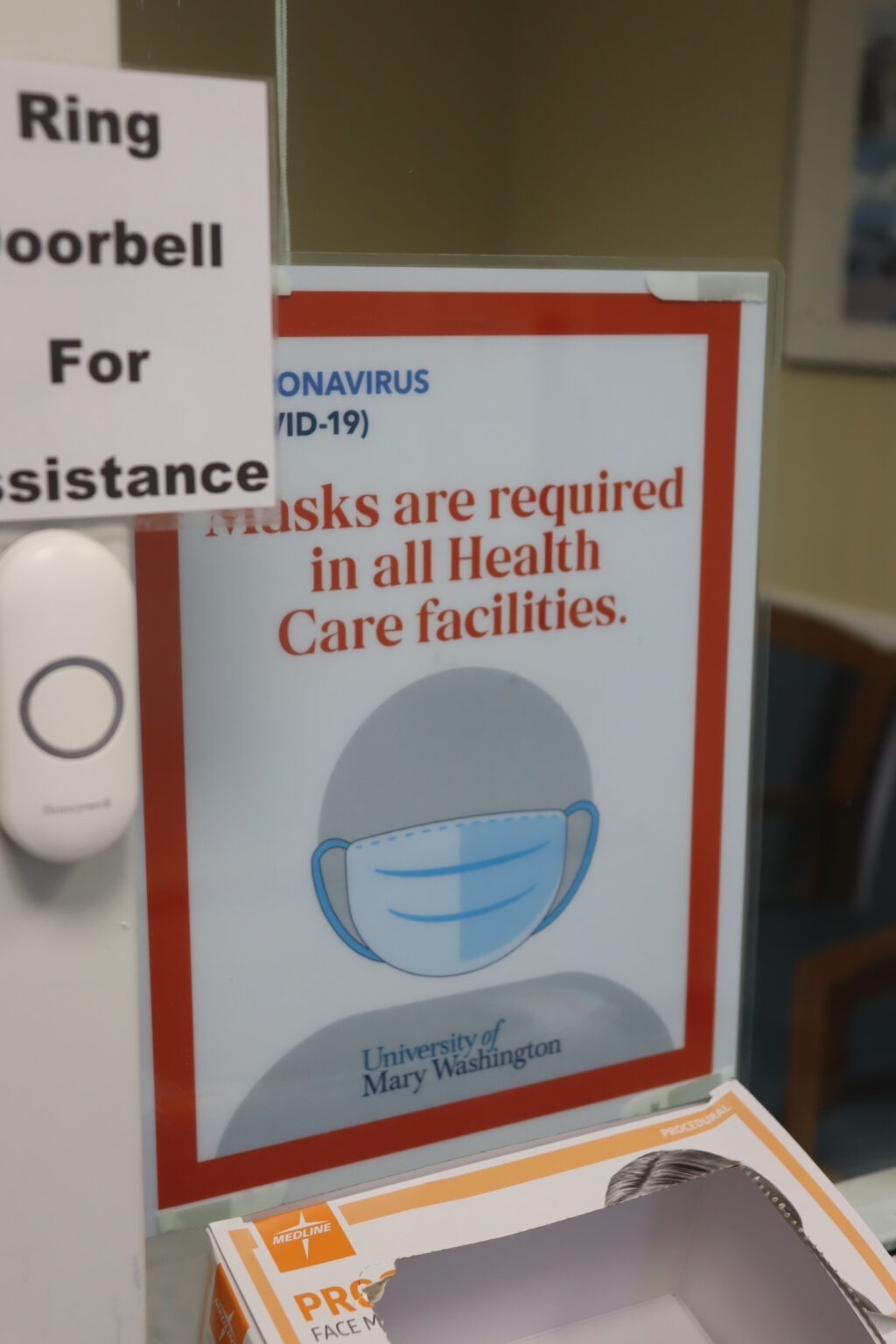UMW faces monkeypox and COVID this fall
3 min read
There are still signs urging people to wear masks in healthcare facilities. | Sarah Sklar, The Weekly Ringer
CALLIE HARKINS
News Editor
The start of the fall 2022 semester has seen two ongoing public health crises: monkeypox and the COVID-19 pandemic. With lessened COVID guidelines at UMW compared to past semesters, some students are concerned about the transmission of the viruses.
As of Sept. 21, there are 440 monkeypox cases and 10,291 COVID cases in Virginia, according to the CDC.
“I’m certainly worried about the spread of monkeypox,” said Cassie Atkinson, a junior political science and communication and digital studies double major. “Granted, I think it is unlikely because the spread is already slowing down, but the fact that we aren’t doing anything to prevent it does worry me. All it takes is one person to contract it for it to spread like wildfire on a college campus.”
In previous semesters, UMW provided the number of COVID cases, tests, and isolation and quarantine spaces available to the UMW community through its COVID dashboard. While this dashboard no longer exists, COVID guidelines on masking, vaccinations, testing and isolation are still available on UMW’s website, and students are encouraged to continue self-reporting COVID cases.
Last semester, students received an email each Friday with the subject “Weekly COVID Update.” Changes have since been made to include monkeypox case information. This semester, members of the UMW community have been receiving weekly health updates from UMW’s Public Health Advisory Working Group, sent out through email by Executive Director of University Communications Amy Jessee.
These weekly emails report a COVID community level using the CDC COVID Data Tracker. The community level has been fluctuating between low and high; it was reported as low on Sept. 2 and Sept. 16 and high on Aug. 26 and Sept. 9.
Some professors have been changing their class locations based on the COVID community levels.
“Our professor wants to ensure that everyone is in good health, so she follows the transmission emails pretty religiously,” said senior Grace Schumacher, a historic preservation and English double major. “Depending on the content of those emails, we will be notified about which classroom we’re going to be in that week, since one classroom is larger than the other.”
Schumacher said that sometimes she sees her classmates wandering the hall, unsure of which classroom to go to.
“It’s tiring to not really know where you’re going to have class every time you show up,” she said.
While COVID cases and community levels have fluctuate week by week, the number of monkeypox cases have mostly remained static.
Some students want more guidance on COVID and monkeypox from the university.
“I think UMW could always do more,” said Atkinson. “Most importantly, I think more candid information about the current infections of monkeypox in the area. I’ve tried my best to find information about this online, and it’s very difficult to locate regional data.”
Atkinson also thinks that it would be beneficial to inform students of what the monkeypox rash looks like.
“Many people also don’t know what the rash looks like which could cause someone to misidentify a rash as an acne outbreak or something similar,” she said. “Addressing these misconceptions could be really helpful in curbing the spread of the disease.”
Some students, like junior business administration major Joseph Modeszto, welcome the relaxed COVID guidelines compared to previous semesters.
“It’s nice being in classes and seeing faces, it helps me engage with people more,” he said.
The World Health Organization declared monkeypox a public health emergency on June 23, 2022, and has continued to collaborate with the Centers for Disease Control to outline health and safety guidelines in response to the ongoing COVID pandemic.
According to a July 26 statement from the UMW Public Health Advisory Working Group, “UMW continues to evaluate the COVID pandemic in accordance with public health guidance and will provide updates to the campus community when there are significant updates from the CDC or an increase in our community levels. We are also monitoring the latest data and information about the spread of monkeypox.”
The American College Health Association has released official recommendations for institutions of higher education. The guidance emphasizes the importance of assessing community risks in accordance with national data. With masks no longer required on campus, the ACHA refers these institutions to local data regarding case numbers.
“I think our community can do better to protect each other and respect the lives of our most vulnerable peers,” said Atkinson.
Jess Kirby, Priya Patel and Daniel Childers contributed to reporting for this article.


